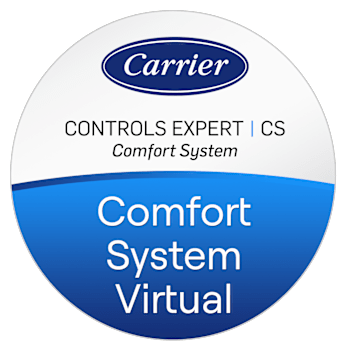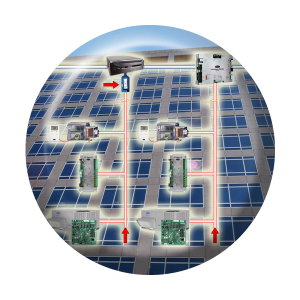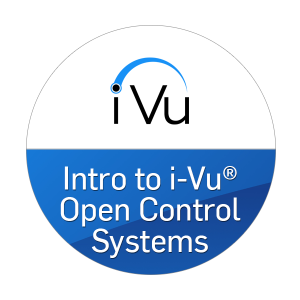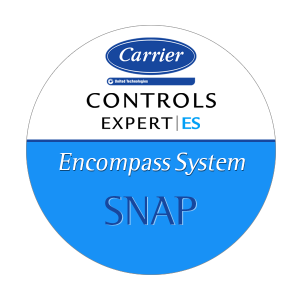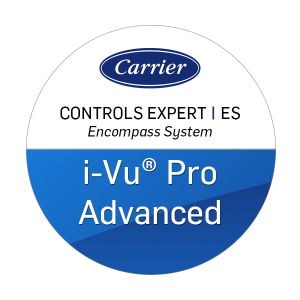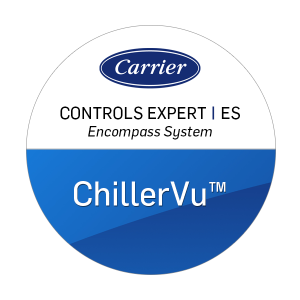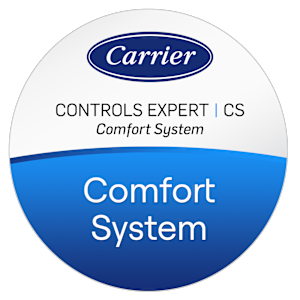Comfort System (CS) Virtual (Using Your Personal Hardware)
CCE CS OL
The CS virtual course is the first in the Carrier Controls Expert Training series. This course is designed for Carrier field technicians, project engineers, distributors or Carrier contractor employees who are looking to better utilize their skills with i-Vu® Tech Tools, VVT Control Systems and VAV Control Systems.
| duration | cost | format |
|---|---|---|
| 9 days | $800 | Online |
The CS virtual course is the first in the Carrier Controls Expert Training series. This course will provide Carrier field technicians, project engineers, distributors or Carrier contractor employees skills to utilize i-Vu® Tech Tools, VVT Control Systems and VAV Control Systems.
The virtual classroom allows the learner 9 days to complete the content equivalent to the 4 day in-person/classroom training. Using video tutorials as the on-demand instructor, learners will execute the workbook tasks and upload assignments using the BASU LMS, asking questions through the discussion board where a dedicated factory instructor will facilitate.
For more information on the Carrier Controls Expert Program, please contact your local Carrier Controls sales representative or visit carrier.com/controls-experts.
Who should attend this training
Carrier field technicians, project engineers, distributors or Carrier contractor employees who are looking to better utilize their skills with i-Vu® Tech Tools or newer, VVT Control Systems and VAV Control Systems.
Learning Objectives
At the conclusion of this course, each student should be able to:
- Install and use the i-Vu® Tech Tool suite proficiently
- Network fundamentals of an Open Controller network
- Install, wire and configure a VVT® System
- Install, wire and configure a VAV System
Training Methods Used
This course uses a video-led virtual training with extensive hands-on tasks to present the material. Student’s achievement of the learning objectives is determined by successful completion of the course and final written exam.
Topics Covered
Addressing Controllers in an Open Controller Network
MS/TP Networks
- Check 7 Different Control Modules
- Communications Check
- Device Instance
i-Vu® Tech Tools Installation
- Install i-Vu® Tools
- Install Apploader®
- Install Test and Balance®
- Install Alarm Notification Client®
- Copy Utilities Folder
- Login to HVACPartners.com
- Download Cumulative updates and Sal files
- Copy Sal Files into i-Vu Tools
- Submit your System Files to BAS University
Configure a Router/Link (using PuTTY®)
- Set the Routers Dip Switches
- Get PuTTY® Ready
- Change the Routers Configuration
Laptop Setup and Field Assistant® Update
- Re-address the Router
- Prepare the Computer for Communications
- Launch FA
- Install the Latest Cumulative Patches
Field Assistant®, Preparing a New Site
- Launch Field Assistant®
- Find Devices
Field Assistant® Site Setup
- Time Broadcasting
- Graphic Interface
- Scheduling
- Trends
- Reports
- Global Modify
Optimizing Downloads
- Marker or Full Source downloads
- Exporting Source Files
- Importing Source files
Apploader
- Clip the AppController
Equipment Builder®
- Create a new Folder
- Start Equipment Builder®
- Create Equipment
Add a Control Program
Commission the Program
- Configure Hardware Inputs and Output
- Manipulate a Few Values
Getting a little more familiar
- Manual Command Modstat
- Manual Command PING
RTU Open lab
- Configure RTU Open
- Change/Lock Values for simulation
RTU Open PID parameter adjustments
- Adjust PID Loops for VVT Zoning System
- Search for econ_pid-da
- Search for clg_pid_da
- Search for htg_pid_ra
VVT Bypass lab
- Configure VVT Bypass Controller
- Test and Balance
VVT Terminal Unit lab
- Configure a VVT Zone Controller
- Test and Balance
VVT Master Terminal Unit lab
- Configure Airside Linkage
- Verify Linkage is Active
- RTU Open, Verify Linkage
Air Source (AppController)
- Configure the I/O Channels
- Scheduling
- Checkout Notes and Reports
- Submit your I/O assignments
VAVB1 Zone Terminal lab
- VAVB1 Configuration
- Test and Balance
- Activate the ZS Sensor
VAVB3 Zone Terminal Unit lab
- VAVB3 Configuration
- Test and Balance
VAV Master Terminal Unit lab
- Configure VAV Airside Linkage
- Setup a Rogue Zone
- Verify Linkage is Working
- Single Point Linkage
- Submit Airside Linkage Verification
Test and Balance
- Connect Test and Balance Tool
- Running Test and Balance
- Clear Parameter Mismatches in Field Assistant®
System Touch
- Access the System Touch Setup Menu
- Change the Admin Password
- Configure Sensor Setup
- Configure Inactivity Timeout
- Discover Control Modules
- Create Group Schedules
Equipment Touch
- Attach to an Open Controller from the System Touch
- View Alarm Sources
- View Schedules
- View Trends
- Equipment Properties Menu
- View Active Alarm Buffer
Factory Reset
- Default settings
Materials needed
You will need a laptop and mouse with these requirements:
- 2 GHz processor
- 2 GB RAM (minimum 4 suggested)
- 30 Gigabyte hard drive with 2 GB disk space free
- 1 USB Port
- 1 Ethernet Port (wired network interface card (NIC))
- Internet Explorer 11/Microsoft Edge/Chrome/Firefox or Safari
- Windows 10 Pro (64 bit)
- Adobe reader installed (free download from the internet)
- An internet connection NOT on the Carrier network
- An HVACpartners account
You will also need the following hardware:
- i-Vu® Tech Tools (part number: USB-TKIT) with latest patches.
- CS training case or equivalent hardware
*In order to complete the lab work, students are required to have access to the needed hardware along with a laptop running the current release of the Carrier I-Vu Tech Tools and necessary cables. The Carrier "Training Case Rental Program" is not available for the virtual training course. Hardware may be purchased through your Sales Office. (allow 6 weeks for delivery)
The CS virtual course is the first in the Carrier Controls Expert Training series. This course will provide Carrier field technicians, project engineers, distributors or Carrier contractor employees skills to utilize i-Vu® Tech Tools, VVT Control Systems and VAV Control Systems.
The virtual classroom allows the learner 9 days to complete the content equivalent to the 4 day in-person/classroom training. Using video tutorials as the on-demand instructor, learners will execute the workbook tasks and upload assignments using the BASU LMS, asking questions through the discussion board where a dedicated factory instructor will facilitate.
For more information on the Carrier Controls Expert Program, please contact your local Carrier Controls sales representative or visit carrier.com/controls-experts.
Who should attend this training
Carrier field technicians, project engineers, distributors or Carrier contractor employees who are looking to better utilize their skills with i-Vu® Tech Tools or newer, VVT Control Systems and VAV Control Systems.
Learning Objectives
At the conclusion of this course, each student should be able to:
- Install and use the i-Vu® Tech Tool suite proficiently
- Network fundamentals of an Open Controller network
- Install, wire and configure a VVT® System
- Install, wire and configure a VAV System
Training Methods Used
This course uses a video-led virtual training with extensive hands-on tasks to present the material. Student’s achievement of the learning objectives is determined by successful completion of the course and final written exam.
Topics Covered
Addressing Controllers in an Open Controller Network
MS/TP Networks
- Check 7 Different Control Modules
- Communications Check
- Device Instance
i-Vu® Tech Tools Installation
- Install i-Vu® Tools
- Install Apploader®
- Install Test and Balance®
- Install Alarm Notification Client®
- Copy Utilities Folder
- Login to HVACPartners.com
- Download Cumulative updates and Sal files
- Copy Sal Files into i-Vu Tools
- Submit your System Files to BAS University
Configure a Router/Link (using PuTTY®)
- Set the Routers Dip Switches
- Get PuTTY® Ready
- Change the Routers Configuration
Laptop Setup and Field Assistant® Update
- Re-address the Router
- Prepare the Computer for Communications
- Launch FA
- Install the Latest Cumulative Patches
Field Assistant®, Preparing a New Site
- Launch Field Assistant®
- Find Devices
Field Assistant® Site Setup
- Time Broadcasting
- Graphic Interface
- Scheduling
- Trends
- Reports
- Global Modify
Optimizing Downloads
- Marker or Full Source downloads
- Exporting Source Files
- Importing Source files
Apploader
- Clip the AppController
Equipment Builder®
- Create a new Folder
- Start Equipment Builder®
- Create Equipment
Add a Control Program
Commission the Program
- Configure Hardware Inputs and Output
- Manipulate a Few Values
Getting a little more familiar
- Manual Command Modstat
- Manual Command PING
RTU Open lab
- Configure RTU Open
- Change/Lock Values for simulation
RTU Open PID parameter adjustments
- Adjust PID Loops for VVT Zoning System
- Search for econ_pid-da
- Search for clg_pid_da
- Search for htg_pid_ra
VVT Bypass lab
- Configure VVT Bypass Controller
- Test and Balance
VVT Terminal Unit lab
- Configure a VVT Zone Controller
- Test and Balance
VVT Master Terminal Unit lab
- Configure Airside Linkage
- Verify Linkage is Active
- RTU Open, Verify Linkage
Air Source (AppController)
- Configure the I/O Channels
- Scheduling
- Checkout Notes and Reports
- Submit your I/O assignments
VAVB1 Zone Terminal lab
- VAVB1 Configuration
- Test and Balance
- Activate the ZS Sensor
VAVB3 Zone Terminal Unit lab
- VAVB3 Configuration
- Test and Balance
VAV Master Terminal Unit lab
- Configure VAV Airside Linkage
- Setup a Rogue Zone
- Verify Linkage is Working
- Single Point Linkage
- Submit Airside Linkage Verification
Test and Balance
- Connect Test and Balance Tool
- Running Test and Balance
- Clear Parameter Mismatches in Field Assistant®
System Touch
- Access the System Touch Setup Menu
- Change the Admin Password
- Configure Sensor Setup
- Configure Inactivity Timeout
- Discover Control Modules
- Create Group Schedules
Equipment Touch
- Attach to an Open Controller from the System Touch
- View Alarm Sources
- View Schedules
- View Trends
- Equipment Properties Menu
- View Active Alarm Buffer
Factory Reset
- Default settings
Materials needed
You will need a laptop and mouse with these requirements:
- 2 GHz processor
- 2 GB RAM (minimum 4 suggested)
- 30 Gigabyte hard drive with 2 GB disk space free
- 1 USB Port
- 1 Ethernet Port (wired network interface card (NIC))
- Internet Explorer 11/Microsoft Edge/Chrome/Firefox or Safari
- Windows 10 Pro (64 bit)
- Adobe reader installed (free download from the internet)
- An internet connection NOT on the Carrier network
- An HVACpartners account
You will also need the following hardware:
- i-Vu® Tech Tools (part number: USB-TKIT) with latest patches.
- CS training case or equivalent hardware
*In order to complete the lab work, students are required to have access to the needed hardware along with a laptop running the current release of the Carrier I-Vu Tech Tools and necessary cables. The Carrier "Training Case Rental Program" is not available for the virtual training course. Hardware may be purchased through your Sales Office. (allow 6 weeks for delivery)
